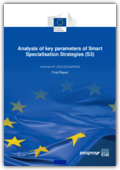
This study follows up the previous research on the 185 smart specialisation strategies for research and innovation developed for the programming period 2014-20 with quantitative analyses of these strategies, their specialisation areas, links to calls and related budgets.
Based on a database with information on each strategy key parameters and implementation, this study provides: i) specific assessment related to interregional cooperation potential, including recommendations on the global positioning of S3 strategies in relation to key industrial innovation ecosystems and value chains; ii) assessment of opportunities related to the green and digital transition, with quantitative analysis of the contribution to key Commission priorities; iii) analysis on related vs unrelated diversification; iv) assessment of links to Horizon 2020; v) analysis of optimal bandwidth of S3 strategies in terms of areas covered relates to the size of an economy (regional, national), its economic diversification, development level and the resources available from European funds; vi) a working paper on the `Nordic Paradox´ of regions scoring well in research and innovation, but with an S3 implementation process below European average and another one on diversification; vii) assessment of the S3 scoreboard with a view to provide a single comparative map, with different levels of development and intensity of funding.